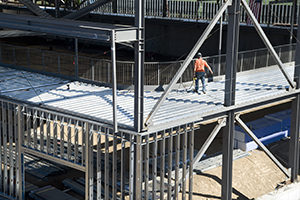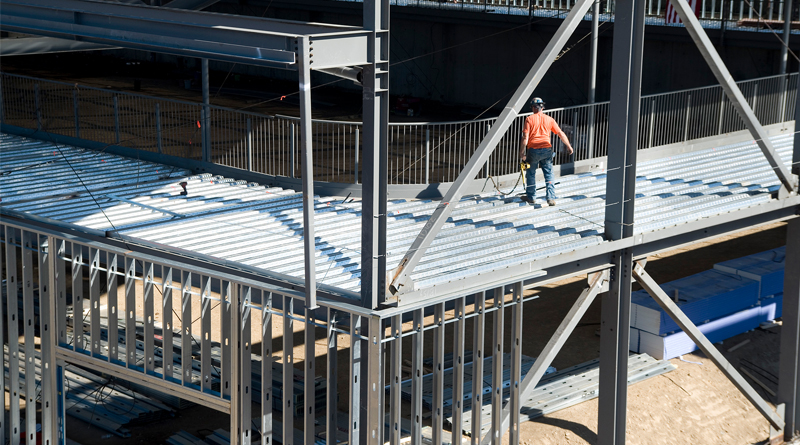By Marc Ciaramitaro
When an academic institution embarks on a construction project — whether it’s an expansion, renovation, new building or other undertaking — the first step is choosing a construction manager (CM). After research, company interviews, cost comparisons and a final decision, you’re good to go, right? Not quite.

Photo Credit: Shelly Harrison Photography
There’s still the matter of trade partner selection. This process is often less familiar to school administrators, and is typically handled by a CM. That said, it’s a process schools should be involved in.
Below are the top-five questions school administrators should be asking CMs ahead of trade partner selection:
What criteria are most important in trade partner selection?
Trade partners are the backbone of success for any construction project, and CMs should only select partners that have been fully vetted and interviewed. They should look for trade partners with expertise that best matches the specific trade scope, availability and capacity to perform the work; an exceptional reputation; and the right cultural fit for the school. The ultimate goal is to provide the best value; so it’s important to weigh these criteria along with overall cost.
How important is it to choose trade partners with relevant experience?
It’s essential to have trade partners with experience working on school campuses. This ensures they’re familiar with operating in academic environments and can manage the logistics of working on an occupied campus. Priority should be given to trade partners with relevant experience and it can be equally beneficial to select those that have previously worked with the CM. That familiarity results in shorter learning curves and an increased sense of safety, security and trust.
Are background checks necessary?
When it comes to construction on school campuses, safety should always be the No. 1 priority. As such, academic clients (especially K-12) are urged to require background checks when not already required by law — even if workers may not have direct contact with students. Ultimately, background checks are a low-cost risk mitigation tool that builds in another layer of safety for the school community. If schools don’t take the lead on a background check process, CMs should implement a process in which trade partners manage the background checks of their own employees. In this scenario, CMs should include in contractual agreements that trade partners need to provide proof of passed background checks prior to working on site.
How will the project team limit disruptions and ensure campus safety?
To minimize campus disruption during construction, it’s important to have processes in place, create open lines of communication and ensure all workers are easily identifiable.
-
- Processes
Before construction begins, create isolated parking and entry points. This limits worker contact with students and faculty, and minimizes overall disruption. Add another layer by staggering construction start and finish times to align with school opening and dismissal. When construction activity begins before school, vehicle traffic won’t interfere with normal school traffic.
Lastly, enforcing a strict sign-in/sign-out process that is safeguarded by the CM’s superintendent is another key safety recommendation. In case of an emergency, the superintendent has a complete count of all people on site.
- Processes
-
- Communication
The Critical Path Method (CPM) schedule is a great tool and visual to manage myriad project details and provides the school with a granular look at what to expect during construction. All activities and adjustments should be proactively communicated to eliminate surprises.
Weekly meetings with key project stakeholders are also crucial to forming open lines of communication. Facilitated by the CM, the goal of the meetings is to discuss the project and provide updates or changes. Regular meetings ensure that all stakeholders are on the same page and up-to-date on the project’s progress.
- Communication
-
- Wearables
Next, think about making trade partners identifiable to students and faculty. Especially in today’s world, it’s extremely important that students and faculty are aware of who has been cleared to be on campus. One of the easiest ways to do this is through wearables and other visual identifiers.
In addition to traditional identifiers such as high-visibility vests, jackets and T-shirts, provide hardhat stickers to workers who have completed a mandatory safety orientation. Without participating in the orientation, workers cannot receive a sticker or set foot on site. Finally, lanyard and badging systems can be used to authorize access to certain areas of the campus. This is vital within occupied buildings where workers are not separated from school activities by a construction fence.
- Wearables
Do trade partners carry their own insurance?
As a key risk mitigation tool, the CM should make sure that trade partners have appropriate insurance to safeguard the school from any liability. This is done by carefully evaluating insurance limits on key items such as worker’s compensation, liability, and umbrella coverage and proper indemnification.
Trade partners should be prohibited from the construction site until they have provided proof of insurance and signed a contract that complies with the school’s requirements.
Marc Ciaramitaro is director of field operations at Windover Construction. For additional information, call 978-526-9410, visit the company website at www.windover.com or email [email protected].


